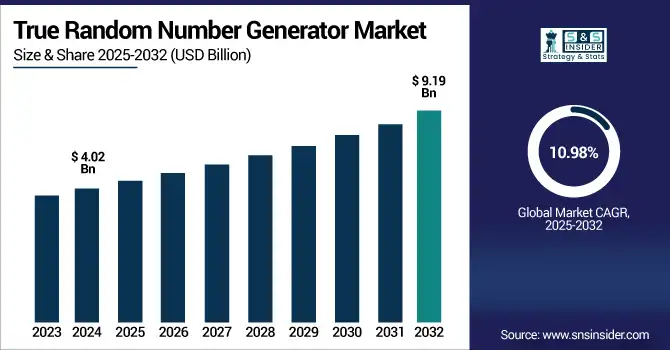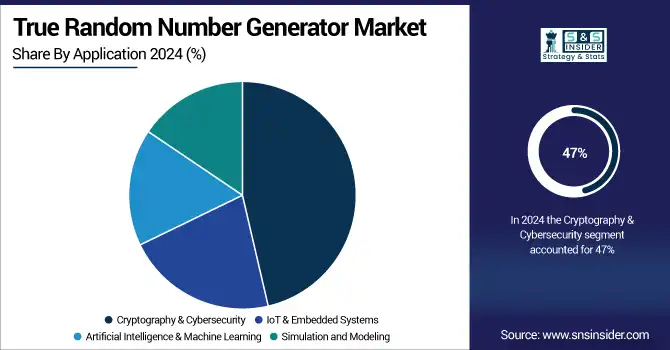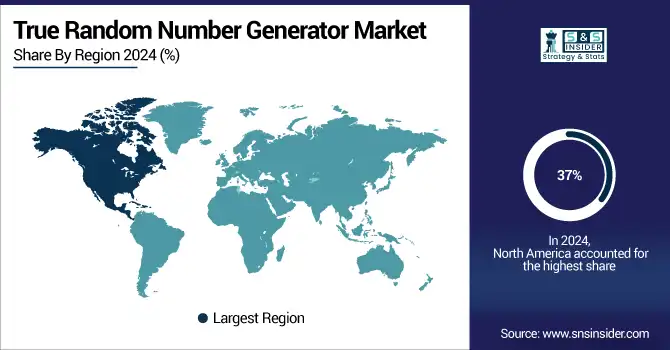True Random Number Generator Market Size Analysis:
The True Random Number Generator Market size was valued at USD 4.02 billion in 2024 and is expected to reach USD 9.19 billion by 2032, growing at a CAGR of 10.98% over the forecast period of 2025-2032.

To Get more information on True-Random-Number-Generator-Market - Request Free Sample Report
The True Random Number Generator (TRNG) market is experiencing strong growth driven by increasing demand for secure encryption, data protection, and advanced simulations across sectors such as finance, defense, and cloud computing. Unlike pseudo-random number generators, TRNGs rely on unpredictable physical processes, offering higher levels of security and randomness. Advancements in quantum technology, integration with edge computing, and regulatory emphasis on data privacy are further propelling market expansion. TRNGs are becoming essential in cryptographic systems, secure communications, and hardware security modules. As digital infrastructures grow more complex and cyber threats more sophisticated, the need for truly random number generation continues to rise, positioning TRNGs as a critical component in modern digital ecosystems.
Quantum Computer Generates Truly Random Number in Scientific FirstIn a major breakthrough, researchers used Quantinuum’s 56-qubit quantum computer to generate a truly random number, verified by supercomputers, marking a new era for quantum-secure applications.
The U.S True Random Number Generator Market size was valued at USD 1.12 billion in 2024 and is expected to reach USD 2.59 billion by 2032, growing at a CAGR of 11.09% over the forecast period of 2025-2032. The True Random Number Generator market growth is mainly attributed to rising demand for secure encryption, a rise in cybersecurity threats, technological advancements around quantum computing, growing applications for True Random Number Generator in finance, defense, and a cloud security market. Further market growth is spurred by rapid digital transformation, regulatory compliance to Data protection Regulation, and further integration of TRNGs in Next Generation hardware and in cryptographic system. Demand for high growth drivers such as high entropy generation, data privacy, non-deterministic nature of connected ecosystem, and security solutions are some of the key growth drivers for the market.
True Random Number Generator (TRNG) Market Dynamics:
Drivers:
-
Rising Cybersecurity Demands and Quantum-Safe Encryption Needs Propel TRNG Market Growth
The increasing quantum-secure cryptography requirements due to the rising cybersecurity attacks, especially with the advent of Artificial Intelligence and Quantum Computing, are boosting the demand for True Random Number Generator (TRNG). With the increased connectivity of digital infrastructure from sectors like finance, IoT, automotive, and defense, there is a growing need for high-quality, non-deterministic randomness in order to protect data transmission and encryption protocols. While traditional sources of entropy are lacking and not scalable, TRNGs draw on quantum principles, allowing them to provide much higher quality and quantity of entropy compared to classical methods, which are becoming essential in future security architectures. The accelerating adoption across embedded systems is also aided by continuous funding for R&D, enabling government initiatives and miniature quantum hardware deployment. All these factors are simultaneously pushing forward TRNG marketplace and the key to a long-term scalability and relevance of TRNG market is attraction of innovation.
Elmos and ID Quantique Launch World’s Smallest Quantum RNG ModuleElmos and ID Quantique unveiled a 2mm x 2mm quantum random number generator, offering ultra-secure encryption with ultra-low power consumption.
Restraints:
-
High Cost and Integration Challenges Limit Widespread Adoption of TRNG Technology
The True Random Number Generator (TRNG) market faces key restraints primarily due to high development and implementation costs, which hinder adoption across cost-sensitive sectors. While quantum-based TRNGs provide better randomness, they typically need special hardware and elaborate calibration procedures, which makes them out of reach for mass market or low-power applications. Second, we face integration challenges due to the quantum nature of TRNGs existing digital infrastructure and embedded systems may be technically difficult to integrate into, especially in legacy environments that do not have quantum-compatible interfaces. Deployment is further hampered by a shortage of expertise and lack of standardization regarding validation methodologies. In addition, doubts about the scalability and long-term reliability of the new quantum TRNG technologies also put potential end-users on the back foot. These reasons combined result in slow growth of the TRNG market and a delay in widespread commercialization.
Opportunities:
The True Random Number Generator (TRNG) market is poised for significant growth as industries increasingly demand advanced cryptographic solutions that offer high entropy and quantum resistance. With rising concerns over data breaches, AI-driven cyberattacks, and the looming threat of quantum computing, TRNGs provide a reliable foundation for secure encryption, authentication, and key generation. Their application spans across cloud infrastructure, IoT networks, financial systems, smart devices, and blockchain technologies where unpredictable, non-deterministic randomness is essential. The push toward post-quantum security standards, coupled with the growing adoption of entropy-as-a-service models, is creating lucrative opportunities for TRNG vendors. As digital ecosystems evolve, the need for scalable, low-power, and easily integrated TRNG solutions will continue to expand globally.
Cryptography Library To Safeguard Transmission And Authentication Of Data Launched By Terra QuantumTQ42 Cryptography suite by Terra Quantum includes open-source, state-of-the-art quantum-resistance algorithms aiming to shield against today and tomorrow’s quantum threats to data, storage.
Challenges:
-
Limited Standardization and Validation Frameworks Undermine Market Confidence in TRNG Reliability
A major challenge in the True Random Number Generator (TRNG) market is the lack of standardized validation protocols and global certification frameworks, which limits trust in the reliability and security of TRNG outputs. These generators are essential to cryptographic applications, which creates concern for the deployment of these applications among enterprises and regulators, due to inconsistent testing and quality benchmarks. This uncertainty pushes back adoption across industries such as finance, defense, and cloud security, where the integrity of data is critical. Further, even the "trueness" of randomness (particularly for quantum-based TRNGs) cannot be queued without high performance random number generators that many organizations do not have. The lack of common international standards and interoperability recommendations prevents a broader acceptance and commercial deployment of TRNG technologies, resulting in overly fragmented markets.
True Random Number Generator Market Segmentation Analysis:
By Type
The Free-Running Oscillator (FRO) based TRNG segment held a dominant True Random Number Generator (TRNG) market share of around 41% in 2024, owing to its low cost, simplicity, and easy integration in the standard chips. Preferred in the IoT space and consumer electronics, they provide an adequate amount of entropy for rudimentary security. They are CMOS-compatible and their small footprint makes scalable, hardware-based encryption available in most of our day-to-day devices.
The Quantum Random Number Generator (QRNG) segment is expected to experience the fastest growth in True Random Number Generator (TRNG) market over 2025-2032 with a CAGR of 11.98%, owing to increasing demand for quantum-safe encryption as quantum computers continue to advance. This makes QRNGs the only truly random source of entropy that can provide better random number quality and that is best suited for high-security applications like finance, defense, the internet of things (IoT), and critical infrastructure, and hence preparing for a future with new cybersecurity threats.
By Application
The Cryptography & Cybersecurity segment held a dominant True Random Number Generator (TRNG) market share of around 47% in 2024, owing to the increasing demand for secure encryption and key generation as well as authentication among digital channels. On the other hand, as the risk of cyber-attacks rises, industries like finance, defense, and cloud computing also use TRNGs to protect over-sensitive information and maintain cryptographic reliability.
The IoT & Embedded Systems segment is expected to experience the fastest growth in True Random Number Generator (TRNG) market over 2025-2032 with a CAGR of 11.85%, due to demand for secure & Resource-Constrained Cryptographic Solutions on IoT devices. TRNGs: Unique in that they provide efficient, hardware-based randomness vital for providing secure data transmission, firmware updates and identity authentication in small and resource-constrained environments.

By Deployment Mode
The On-Chip TRNG segment held a dominant True Random Number Generator (TRNG) market share of around 53% in 2024, due to their ability to integrate well with microcontrollers, processors and secure elements. Because of its small footprint, low power requirements, and relative cheap price, it is perfect for mass adoption in consumer electronics, automotive, and IoT devices. Strong embedded security demand reinforces its leading market position.
The Cloud-Based TRNG Services segment is expected to experience the fastest growth in True Random Number Generator (TRNG) market over 2025-2032 with a CAGR of 11.61%, as demand grows for scalable, on-demand cryptographic randomness for numerous applications in the cloud computing, blockchain, and virtual environments sectors. Cloud-based TRNGs are gaining adoption among enterprises because they do not have to carry any physical mechanism in the organization, yet can make sure that key generation and encryption can be done safely across the distributed system.
By End Use
The Consumer electronics segment held a dominant True Random Number Generator (TRNG) market share of around 31% in 2024, owing to high penetration of TRNGs in smartphones, smart TVs, wearables and gaming devices. This demand redundancy for secure authentication, for encrypted communications and for protecting privacy setting in everyday digital gadgets has fueled the TRNG integration, especially on-chip TRNG because of their low power consumption for real time entropy generation.
The Financial Institutions segment is expected to experience the fastest growth in True Random Number Generator (TRNG) market over 2025-2032 with a CAGR, With the rise in cyber-attacks, coupled with the rapid growth of digital banking, financial institutions are using TRNGs for secure key generation, transaction authentication, and data protection. The division has been aided by high regulatory compliance and quantum-safe encryption dilemmas along with a strong shift towards secure cloud infrastructure.
True Random Number Generator Market Regional Insights:
In 2024, North America dominated the True Random Number Generator (TRNG) market and accounted for 37% of revenue share, with strong demand for random numbers across cybersecurity, defense, finance, and cloud computing sectors. Widespread adoption can be partially attributed to the technological maturity of the region, quantum-safe encryption investments made in the region, and the major TRNG vendors located in the region. Furthermore, the rise of rising regulations on data protection and the quantum-enabled cyberattacks are pushing TRNG across critical infrastructure and enterprise applications.
Asia-Pacific is expected to witness the fastest growth in the True Random Number Generator (TRNG) market over 2025-2032, with a projected CAGR of 11.89%, due to the growing electronics manufacturing sector, enhanced cybersecurity initiatives, and rising investment in quantum technologies in China, Japan, and South Korea. The increasing utilization of secure IoT, 5G infrastructure and blockchain applications in the region is expected to further drive the adoption of TRNG in consumer products and industrial use cases.
In 2024, Europe emerged as a promising region in the True Random Number Generator (TRNG) market, owing to the increasing demand for data security, suitable regulatory framework such as GDPR, and high investment on post-quantum cryptography. TRNG implementation across the finance, automotive and defense sector is being propelled by the regions ambitions on forming a secure digital infrastructure and government-backed quantum research initiatives. The further development of the market will be enhanced by the presence of the key tech players across the EU nation.
LATAM and MEA are experiencing steady growth in the True Random Number Generator (TRNG) market, driven by increasing digital transformation, rising cybersecurity awareness, and gradual adoption of secure communication technologies. Government initiatives to strengthen digital infrastructure, coupled with growing demand for encryption in banking and telecom sectors, are supporting TRNG deployment. Although still emerging, these regions present long-term opportunities as tech adoption and regulatory focus continue to expand.

Get Customized Report as per Your Business Requirement - Enquiry Now
Key Players:
The True Random Number Generators Companies are ID Quantique, Quantinuum, Infineon Technologies, Rambus Inc., Microchip Technology, STMicroelectronics, NXP Semiconductors, Synopsys, Samsung Electronics, Texas Instruments, Intel Corporation, Analog Devices, ON Semiconductor (onsemi), SK Telecom, Toshiba Digital Solutions, PQCure, Quside Technologies, Crypta Labs, Securosys SA, EpiSci and others.
Recent Developments:
-
In Feb 2025, Synopsys has introduced a compact, standards-compliant True Random Number Generator (TRNG) for secure key generation in IoT, automotive, and military applications. It features configurable entropy sources, high-speed output, and FIPS-ready design.
-
In Sept 2024, Samsung has launched the Galaxy Quantum 5 in South Korea, featuring a built-in Quantum Random Number Generator (QRNG) chip for enhanced encryption and device security. Co-developed with ID Quantique, it marks a leap in consumer-grade quantum-secure mobile technology.
| Report Attributes | Details |
|---|---|
| Market Size in 2024 | USD 4.02 Billion |
| Market Size by 2032 | USD 9.19 Billion |
| CAGR | CAGR of 10.98% From 2025 to 2032 |
| Base Year | 2024 |
| Forecast Period | 2025-2032 |
| Historical Data | 2021-2023 |
| Report Scope & Coverage | Market Size, Segments Analysis, Competitive Landscape, Regional Analysis, DROC & SWOT Analysis, Forecast Outlook |
| Key Segments | • By Type (Free-Running Oscillator (FRO) based TRNG, Noise-based TRNG, Quantum Random Number Generator (QRNG) and Chaos-based TRNG), • By Application (Cryptography & Cybersecurity, IoT & Embedded Systems, Artificial Intelligence & Machine Learning and Simulation and Modeling) • By Deployment Mode (On-Chip TRNG, Standalone TRNG Module and Cloud-Based TRNG Services) • By End Use (Enterprises, Consumer electronics, Government Agencies, Financial Institutions, Telecom Operators and Others) |
| Regional Analysis/Coverage | North America (US, Canada, Mexico), Europe (Germany, France, UK, Italy, Spain, Poland, Turkey, Rest of Europe), Asia Pacific (China, India, Japan, South Korea, Singapore, Australia, Taiwan, Rest of Asia Pacific), Middle East & Africa (UAE, Saudi Arabia, Qatar, South Africa, Rest of Middle East & Africa), Latin America (Brazil, Argentina, Rest of Latin America) |
| Company Profiles | ID Quantique, Quantinuum, Infineon Technologies, Rambus Inc., Microchip Technology, STMicroelectronics, NXP Semiconductors, Synopsys, Samsung Electronics, Texas Instruments, Intel Corporation, Analog Devices, ON Semiconductor (onsemi), SK Telecom, Toshiba Digital Solutions, PQCure, Quside Technologies, Crypta Labs, Securosys SA, EpiSci. |

